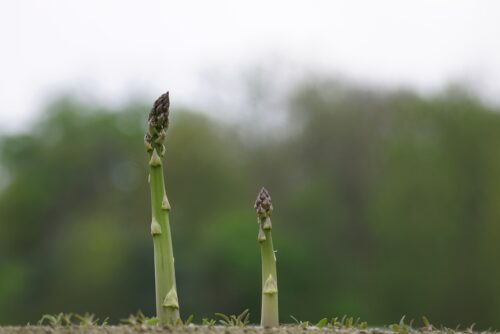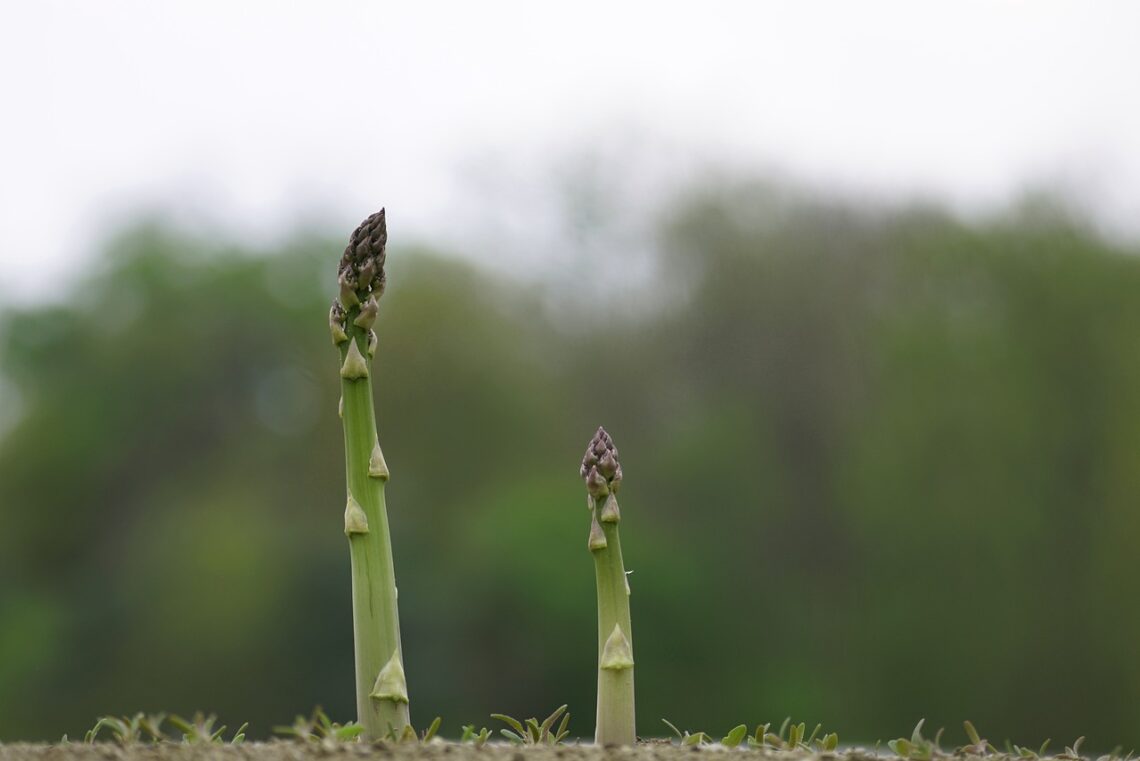Learn how to grow Asparagus in Home Gardens and also read about its growth stages and varieties in this guide.

Asparagus (Asparagus Officinalis) is a perennial vegetable that can be harvested earliest during each spring. The harvest season lasts about 6-8 weeks, from May to late June in Minnesota. It matures slowly and takes 3-5 years to fill entirely. When they start producing in good amounts, you will have asparagus spears every spring for more than a month.
The edible parts of asparagus are known as spears; technically, these are the stems of the plants that develop from underground buds at the base of the root system; these roots and buds are termed ‘crowns.’ If you allow the spears to grow, they produce leaves known as ‘ferns.’ Asparagus is planted from crowns or roots during early spring.
Asparagus Growth Stages
Asparagus has three main stages: the spear stage, the fern stage, and the dormant stage, which arises in the winter.
- Spear Stage: This is the first edible stage; spears are young stems or shoots. They last between 6 and 8 weeks, starting in late April or early May.
- Fern Stage: When allowed to mature, the spears become tall ferns covered in small leaves.
- Dormant Stage: When plants are not growing above the ground in the dormant growth stage.
How to Plant Asparagus
The asparagus spears do not become adequately big to harvest for up to three years, but you can start preparing the bed for the best results. Choose a spot in the vegetable garden or create a separate bed. It requires space, so plant the crowns 12-18 inches apart.
Heirloom asparagus varieties take more space as both male and female plants produce seeds and self-sow. Hybrid cultivars only produce male plants without any seeds and spread over the growth of the existing crown.
When to Plant Asparagus
Plant the asparagus crowns during early spring once the soil can be worked.
Propagating Asparagus
You can propagate asparagus from a 1-year-old plant known as crowns or grow from seeds. Propagation from the crown is easier and faster than propagation from seeds. Select a sunny, fertile, well-draining area with soil that retains moisture. Remember that late spring frost can kill developing spears; hence, search for an area that is not exposed to frost.
The best place for an asparagus bed is at the north end of the home garden.
Starting Asparagus from Seeds
Some varieties like ‘Purple Passion’ and hybrid ‘Sweet Purple’ can be grown from seeds. During spring, start seeds indoors and move seedlings out once they are 12-14 weeks old after last spring’s frost.
- Soak the seeds for up to 24 hours in water before planting.
- Sow seeds in moist seed-starting soil or peat in trays. When the plants grow up to 12 inches tall, acclimate them outdoors for a week.
- After the last spring frost, young plants will be moved to a temporary garden bed. When they mature during the fall, transplant berry-less male plants to a permanent site and discard low-yielding female plants.
Starting Asparagus from Crowns
Dig a 6-12 inch deep trench for the crowns in length as long as the number of crowns you will plant. For instance, for planting ten crowns, dig a 10-foot-long furrow. Put the crowns ‘head-to-toe’ (bud-to-root tip) in a line. When planting, amend the soil with potassium and phosphorus fertilizer.
Narrow, small spears pop up from the soil within 2-3 weeks of planting; when they become tall and sturdy, carefully back-fill more soil into the furrows as large dolts of dry soil can break the fragile spears.
Types of Asparagus
The new hybrid varieties are bred for all males; they use all their energy to produce the vegetable and not set seeds; some of the best varieties are;
- ‘Jersey Giant‘: Resistant to fusarium wilt and rust, it sets vegetables early.
- ‘Mary Washington‘: This common variety is bred for rust resistance.
- ‘Princeville‘: It performs well in warm climates,
- ‘Purple Passion‘: It is a purple variety.
- ‘Brock Imperial‘: This variety is loved for its high yields.
Ideal Growing Conditions for Asparagus
Location
Choose a site that receives full sun; in the absence of adequate light, you will end up with thin spears and weak plants prone to disease.
Soil
Asparagus does well in well-draining soil with a pH between 6.5 to 7.0; test the soil before planting, and amend the soil with 1.5 pounds of (10-10-10) NPK per 100 square feet.
Note: Avoid using a fertilizer that contains herbicide, as it can kill the plant.
Water
For good roots and fern growth, soil moisture is essential. The plant requires constant moisture for a healthy crop. Water the patch at least once every week if there is no inch of rain last week. If growing in sandy soil, water more than once per week. You can add drip irrigation or a soaker hose to the bed as well.
Temperature and Humidity
In the growing season, asparagus favor 70-80 F in the day and 60-70 F at night. During spring, it will start to produce shoots when the soil temperature is 50 F. Frost after emerging shoots can cause discoloration. The growth will affect and slow down when the temperature is above 85 or below 55 F.
Asparagus Care
Fertilizer
Apply compost while preparing the asparagus bed, and add an all-purpose organic fertilizer to the furrow. Use rock phosphate to encourage root growth. Top dress the soil with compost in early spring before shoots emerge or during fall after ferns died back and cut to the ground level. Feed asparagus in mid-spring in its active growth phase.
Harvesting
During spring, spears begin to come out from the soil. Avoid harvesting any spears in the first spring, a year after planting the crowns. Allow the spears to turn ferns. In the second spring, after propagating crowns, if plants are strong, you can start harvesting once spears are 6-8 inches long.
In the first year of harvest, pick vegetables for two weeks and allow them to develop into ferns. To make the plant more strong, begin harvesting in the third year.
Storage
Enjoy fresh harvest in spring after picking or keep in the refrigerator for up to a week after putting in a plastic bag.
You can keep the harvested in the freeze.
Green vs. White Asparagus
Both green and white asparagus plants are the same, but they turn white after blanching, which results from light deprivation, so they do not photosynthesize. It is done by covering the spears with a plastic tunnel or soil. The produce is white, smooth, and fiber-free in appearance; harvested spears are chilled to avoid fiber formation.



